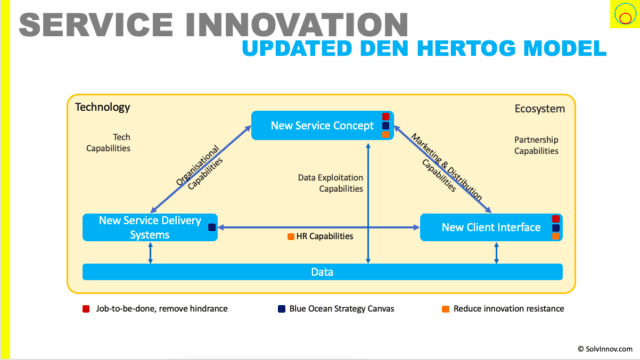The Big Picture…
How difficult will it be to execute your innovation in your enterprise? That is to say, can we determine what I will call its Innovation Execution Complexity?
Innovations – new ways of helping beneficiaries make progress they are seeking – stumble, in part, because they are, or are perceived to be, too difficult to implement/execute. We often set off on execution and fail, or fail to set off.
I’ll look at how we can determine how complex it is to execute an innovation in a particular enterprise. And do so by leveraging any model in the style of Den Hertog’s model of services (such as my Services Model for the Modern World).

The idea is quite simple. Den Hertog style models include two components:
- dimensions – describing the new proposed service
- capabilities – relating to your enterprise (such as technology, data, organisational, HR, Marketing)
An innovation is a change in these dimensions. And so, for any innovation, we can determine how complex it will be to execute, in a specific enterprise, by dividing the size of the changes by the strength of the capabilities of the enterprise.
In practice we will wish to provide guidance on how to determine these values.
And we may wish to have a more detailed equation. For example weighting different parameters. But that is an implementation detail.
Implications
By not being able to quantify Innovation Execution Complexity we have limited arguments against the “this is too complicated” view. Making our innovation activities little more than innovation theatre. And so we contribute to the innovation problem.
However, once we can determine an execution complexity for an innovation idea, we can use it in several ways beyond just communicating it. For example, to:
- search for simplifications in the innovation, i.e. minimise size of change
- or to justify
- investing in improving enterprise capabilities, i.e. maximise the change capability
- enabling activities, e.g. data cleansing, that minimise size of change
Additionally, if we have a set of innovation ideas and we determine execution complexity level ideas for them all, then we can use those scores in our management of our innovation portfolio
The idea
We have an innovation problem. And the default way enterprises, and usually the innovation consultants that advise them, attempt to solve that is by focusing heavily on generating and funnelling ideas.
But enterprises can find it challenging to understand and/or execute ideas – or worse, not even know how simple or difficult an idea is to execute. And so they either set off on execution and fail, or fail to set off. Both paths lead us down the path of innovation theatre. And by doing that, we contribute even further to the innovation problem.
We can begin to solve the understanding idea by closing the language gap. Perhaps by using the lean canvas in an iterative manner. The second challenge – of understanding how complex it will be to execute an innovation in a particular enterprise – we can do so by leveraging den Hertog’s style models of service innovation (e.g the original or my enhancement).
Recap of Models of (service) innovation
Den Hertog style models have 3 components:
- dimensions – such as technology, new service concept, data etc
- capabilities – such as HR, partnership etc
- comparisons of the dimensions
Here in Figure 1, you can see my enhanced model of service innovation. It builds on den Hertog’s original, adding dimensions of data and ecosytem. Together with associated capabilities.
The dimensions are:
- Service Concept
- Client Interface
- Service Delivery Systems
- Data
- Technology
- Ecosystem
And there are various associated capabilities of the enterprise. Four of these link dimensions:
- HR Capabilities
- Organisational Capabilities
- Marketing & Distribution Capabilities
- Data Exploitation Capabilities
Whereas a further two capabilities are common to all dimensions: tech and partnership capabilities.
What is an Innovation?
An innovation, including product innovation, is a combination of changes in one or more dimensions in the model.
We could, for example, see the move of banking from high street to online as a change in the service concept. And that requires changes in technology, the client interface and delivery systems. To drive those changes we need to re-organise the enterprise, alter employees roles, convince the customers, change technology, etc.
Updating a goods usually results in a change to the service delivery system. Remember that we should see goods as a distribution mechanism for service. And it may also update the client interface (if it needs to be used differently, for example). Again, the strengths of various enterprise capabilities will affect the complexity of execution.
Now we can get to the insights.
What is innovation execution complexity?
Innovation execution complexity can be seen as some measure of the size of the change an innovation requires to the enterprise, compared to the enterprise’s capability to make the change. Which we can affect in two ways:
- increasing capabilities strengths, and/or
- decreasing the size of the change
It’s important to recognise that this complexity refers to a specific enterprise. Since the size of change and strength of capabilities are different in different enterprises.
And this leads us to an easy observation as to why new entrants find it easier to execute than incumbents:
- changes in dimensions is smaller as their existing either doesn’t exist or is less invested in (potentially allowing for quicker pivoting)
- capabilities are likely to be laser focussed on delivering one thing than spread across several enterprise initiatives
Finally, let’s note that the change required for the beneficiary is captured under the client interface. We would prefer to keep that size of change minimal. And that is a field well studied under innovation adoption (and the equally important, though less-studied, aspects of innovation resistance and value co-destruction).
OK, so let’s look at how we can put a value on this notion of innovation execution complexity.
Determining Execution Complexity of an Innovation
As the Innovation Execution Complexity is a function of size of the change and the capabilities of the enterprise, the we can simplistically measure it as follows :
- the size of the change of each dimension, say between 1-10, and sum them up (
).
- the strength of the enterprise’s capabilities, again, say between 1-10, and sum them up (
)
- divide those two figures gets us an execution complexity score:
Here’s a quick example in Figure 2.
We determine the innovation in Figure 2 has execution complexity of 2. And that comes from determining a) it has a size of change equal to 20 and b) our enterprise has a strength of capabilities of 10.
Let’s see how we can determine those two components.
Sizing the Change
For each dimension in the model, we assign a value to represent the size of change the innovation requires. Let’s say this will be on a scale of 1-10. This scoring comes from examining the current situation of the dimension and the expected new situation.
And, from personal experience, it is best to guide the scores with relatively concrete examples. Otherwise, one person’s 3 is another person’s 8. And you end up with inconsistencies.
You can see such a guiding framework in Figure 3. Where, for example, a score of 0 for the new service concept dimension would indicate no change is required. Whereas a score of:
- 2 – indicates we think this is a relatively simple incremental change to the service concept compared to the existing concept
- 5 – indicates we are combining existing services together to create a new service. This is often slightly more complicated than incremental change
- 10 – is a completely new service concept, which naturally should attract the highest score on this scale.
You do this for each of the dimensions. And you may need more than one interpretation for each dimension. New Client Interface, for example, probably needs to look at the change from a client (beneficiary) perspective as well as your own enterprise.
Working out the strength of Capabilities
Similar to scoring size of change in dimensions for an innovation, we score the enterprise’s capabilities strengths. Or if the enterprise is large, we score the strengths of the executing unit. Unlike previous, this is not innovation dependent, i.e. does not change for different innovations.
As you can see in Figure 4, we score each capability in out den Hertog style model. And similarly we pick a scale of 1-10.
Experience also tells us to provide guidance on what scores mean. So, 0 we mark as indicating we have no capability. And 10 as we are experts. In a real implementation we would provide guidance for the other scores as well.
Innovation Execution Complexity
With scores for innovation change size and the enterprise’s capability, we can determine an execution complexity for that innovation in this enterprise.
A simplistic approach is to divide one score by the other. As shown in Figure 5.
In real life it might be the case that a more comprehensive algorithm is required. Perhaps line items are weighted to reflect varying impacts of size changes and capability strengths. That is something that would be determined by practical implementation of this approach.
Wrapping Up
We have seen that we can use den Hertog style models to determine execution complexity for an innovation. It helps if we provide guidance for the scaling, i.e. what does a score of 1 or 7 or whatever mean. And this guidance could vary between enterprises. However, it is advisable to keep the same guidance within an enterprise (or unit if that is more appropriate).
Determining the execution complexity can simplistically be done by dividing the size of the change by the strength of the enterprise’s capabilities. It might be that more sophisticated algorithms are needed in real life. Something that will become clear on further use.
The benefit of determining execution complexity is that we can now work through how to reduce the size of the change and/or improve the enterprise’s capabilities; if required. And hidden here is the notion of executing enabling changes. You might execute changes that themselves do not bring direct returns, but make the execution of innovations simpler. For example, master data cleansing is rarely a glamorous task, but doing so might reduce future size of changes for data dimension.
Finally, as we can score one innovation, we can score many. This opens up the opportunity for feeding scores into portfolio management.




